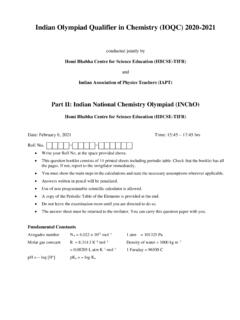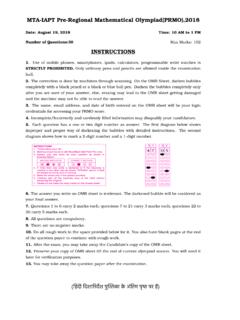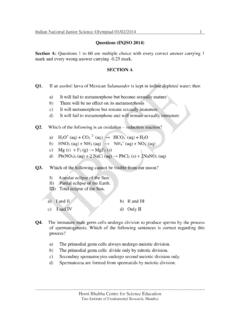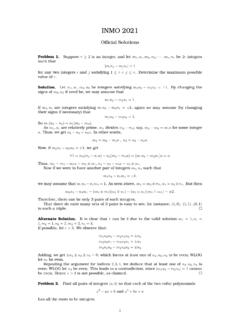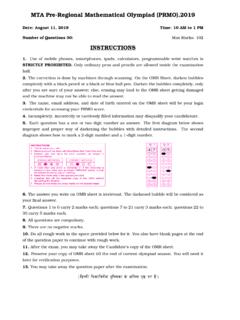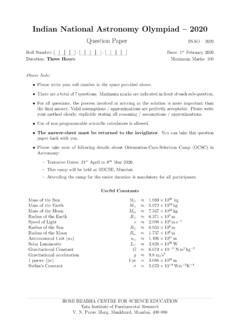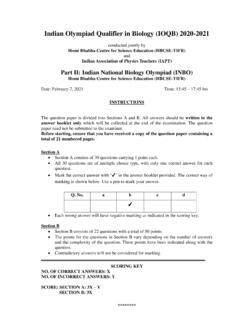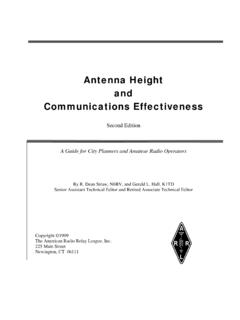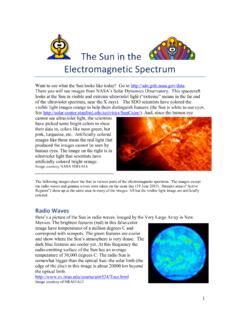Transcription of Indian Olympiad Quali er in Astronomy (IOQA) 2020 { 2021
1 Indian Olympiad Qualifier in Astronomy (IOQA)2020 2021conducted jointly byHomi Bhabha Centre for Science Education (HBCSE-TIFR)andIndian Association of Physics Teachers (IAPT)Part II: Indian National Astronomy Olympiad (INAO)Homi Bhabha Centre for Science Education (HBCSE-TIFR)Question PaperDate: 6thFebruary 2021 Time:10:15 12:15 hrsRoll Number:rorororo-rorororo-rorororororoMax imum Marks: 80 Please Note: Please write your roll number in the space provided above. There are total 5 questions. Maximum marks are indicated in front of each sub-question. For all questions, the process involved in arriving at the solution is more important than the finalanswer. Valid assumptions / approximations are perfectly acceptable. Please write your methodclearly, explicitly stating all reasoning / assumptions / approximations. Use of non-programmable scientific calculators is allowed.
2 The answer-sheet must be returned to the invigilator. You can take this question paperback with ConstantsMass of the SunM 1030kgMass of the EarthM 1024kgMass of the MoonM$ 1022kgRadius of the EarthR 106mSpeed of Lightc 108m s 1 Radius of the SunR 108mRadius of the MoonRm 106mDistance of the Moon from Earthd$ 108mAstronomical Unita 1011mGravitational ConstantG 10 11N m2kg 2 INAO 20211. A Newtonian reflector type of telescope has a concave mirror with a m radius of curvature asits primary mirror. It is fitted with camera at primary focus with an achromatic camera lens cm focal length.(a) (2 marks) What is the angular magnification of this system?(b) (3 marks) We observe a 25 000 km diameter sunspot with this system. What will be theangular size of the sunspot in the image?(c) (7 marks) The camera lens is now removed and an image detector is placed in such a waythat a well-focused sunspot image due to primary mirror could be observed with yellow light(wavelength 550 nm).
3 We wish to observe the same region now in green light (wavelength465 nm). For this, we introduce a green filter, which blocks all other wavelengths except greenlight, in front of the detector. If the thickness of this plane parallel glass plate (refractive ) ist= mm, how much will be the change in the position of the image?2. A rectangular sheet of paper was rolled to form a cylinder, with exactly two layers of sheet alongthe curved surface. This cylinder is cut such that the plane of the cut makes an angle of 45 withthe axis of cylinder. The paper was then unrolled and spread on a flat table.(a) (2 marks) Draw a figure to show how the unrolled paper would appear.(b) (4 marks) Justify your answer with appropriate mathematical Betelgeuse, a red supergiant star, in the constellation of Orion, is known as an irregular variable s magnitude varies between + to + from time to time.
4 However, last year the astronomerswere surprised to observe an unexpected dimming of Betelgeuse. We may assume this event startedfrom 12 October 2019. Given below is a plot of the observed magnitude vs time (light-curve) : The relation between magnitude of the star and light flux received from it is given by :m1 m2= (F1F2)wherem1andm2are magnitudes measured in two different observations andF1andF2arecorresponding light fluxes. Mass of Betelgeuse:MB= 1031kg Distance of Betelgeuse from the Earth:dB= 200 pc Typical radius of Betelgeuse:R1= 1011m(a) (8 marks) One of the proposed model for this dimming was that the whole star suddenlystarted expanding and hence cooled down. Let us assume that the star is still acting as perfectblack body at each stage of expansion (and subsequent contraction). By other measurements,we know that the star s effective temperature at the start of expansion wasT1= 3500 K andthe effective temperature at the most expanded state isT2= 2625 K.
5 Find the average velocityof the expansion of gas.(b) (9 marks) Some other astronomers proposed that the said dimming is caused due to the transitof a giant exoplanet with radius r orbiting Betelgeuse. Argue if such a scenario is possiblefor an edge-on circular orbit of the exoplanet with orbital radius a .1 INAO 2021 Figure 1:The V band magnitudes are observations from the AAVSO International Database( )(c) (7 marks) A popular model to explain this dimming states that this event started with alarge plume of hot material getting ejected from the star s surface. This material cooled downafter ejection and became opaque to block light from a part of the star. As this dense cloudexpanded, it kept blocking more and more part of the star dimming it further. However, asthis expansion lowered the density of the cloud, the cloud s opaqueness started reducing aftera few weeks and the star started brightening we will consider a simpler version of this model.
6 We assume that this material ejectionhappened in a narrow cone in very short timescale from a single point on the non-rotatingstellar surface. The total mass of the ejected material was approximately equal to mass of theearth and the axis of the cone was exactly along our line of sight. Let us assume that at eachinstant during the expansion the density of material is constant throughout the cone and thevertex of the cone is still attached to the stellar assume that the star starts brightening again when the average density inside the conefalls to 5 10 14kg m 3. Find the time averaged velocity of particles, which form the front ofthe expanding (20 marks) A space agency would like to put an artificial satellite in a highly elliptical orbit aroundthe Earth in the ecliptic plane (the plane of the Earth s orbit around the Sun). What can be themaximum eccentricity (emax) for such an orbit?
7 Also provide the perigee (rmin) and apogee (rmax)distances (in km) from the centre of the 20215. (18 marks) Five friends from various cities of India observed the Sun and made the followingstatements. For their observations of shadows they all used a metre stick placed vertically on a I observed sunrise at 04:56 on I observed sunrise at 05:24 on 12thJune, which was the second earliest out of the five citieson that I observed sunset at 16:55 on I observed sunset at 17:35 on 24thDecember, which was the third earliest out of the five citieson that I observed sunset at 18:50 on 1stSeptember, which was the last sunset on that At local noon ( noon as per each local time) on 21stJune, shadow at my location was thelongest amongst The shortest shadow of the year at my location was observed on The shortest shadow of the year at my location was observed on The shortest shadow of the year at my location was observed on The shortest shadow of the year at my location was observed on On 1stJuly, I had a longer day as compared to other On 1stFebruary, I had a longer day as compared to other are the locations of our observers along with the coordinates of their cities; N, N, N, N, N, EAssume that all observers have their watches synchronised to correct Indian Standard Time.
8 Findout, for each statement, which statement was made by which observer?Note:You don t have to give reasons. Only a table with observer name and statement numbersis enough. Each correct pair gives you marks. However, for each wrong pair, you will lose

